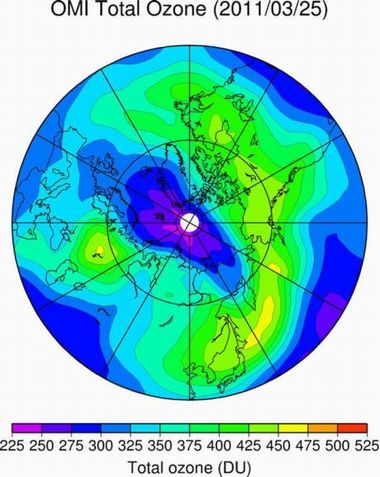January 11, 2012
Ozone Depletion Creates Largest Ozone Hole in Arctic
Keywords: Climate Change Ecosystems / Biodiversity University / Research institute

Created by the National Institute for Environmental Studies based on the data provided by NASA
Copyright National Institute for Environmental Studies
Ozone depletion over the Arctic reached unprecedented levels in early spring of 2011, and its extent was comparable to that in the Antarctic ozone hole, according to a study conducted by a team of scientists from 18 institutions across 9 countries, including Japan's National Institute for Environmental Studies (NIES). The study was published online on October 3 in the journal Nature and appeared in its October 27 issue.
In the study, scientists measured ozone concentrations using NASA's observation satellites and ozone-sonde profilers set up in the Arctic region encompassing eight countries. The NIES was in charge of ozone-sonde observations over Russia. Chemical ozone destruction is caused by chlorine compounds such as chlorofluorocarbons (CFCs). Atmospheric chlorine concentrations have been declining in recent years, thanks to the international efforts to reduce CFC emissions; however, in early 2011, temperatures in the Arctic stratosphere plummeted below minus 80 degrees Celsius for nearly four months, resulting in increased production of ozone-destroying forms of chlorine (active chlorine) for longer periods. This led to the significant ozone loss in the Arctic, as much as 80% at an altitude of 18-20 kilometers.
The total ozone values in the Arctic in early 2011 reached record lows, and for the first time, were comparable to the lowest levels in the Antarctic (<1 ppmv*). Ozone depleted skies covered Scandinavia and the northern Russia, resulting in increased levels of ultraviolet radiation. Researchers warn of that a similar magnitude of ozone depletion could happen in the future and thus careful monitoring of ozone loss should also be carried out in the Arctic region.
*"ppmv": parts per million by volume
Record 40% Loss Detected in Arctic Ozone Layer (Related JFS article)
http://www.japanfs.org/en/pages/031189.html
Posted: 2012/01/11 06:00:15 AM
Reference
Unprecedented Arctic ozone loss in 2011
http://www.nature.com/nature/journal/v478/n7370/full/nature10556.html
National Institute for Environmental Studies (NIES) official website
http://www.nies.go.jp/index.html
Related
"JFS Newsletter"
- Shaping Japan's Energy toward 2050 Participating in the Round Table for Studying Energy Situations
- Implementation of the Paris Climate Agreement: A Report on Japan's Round Table for Studying Energy Situations
- Auto Sales Industry Cooperates to Tackle Social Responsibility: Examples from Yamagata, Japan
- Yokohama FC: Leader in Eco-Activities through Football-Related Carbon Offset
Related
"Popular Articles"
- Large Ozone Hole Observed Again in 2011
- Japan's Pro Baseball Teams Start Eco-Project to Cut Energy Use by 6%
- Manufacturer Saving Energy by Growing Vertical Gardens on Factory Walls
- Sony Draws Up 'Road to Zero' Plan for Zero Environmental Footprint
- Tokyo Announces Innovative 10-Year Strategy against Climate Change


